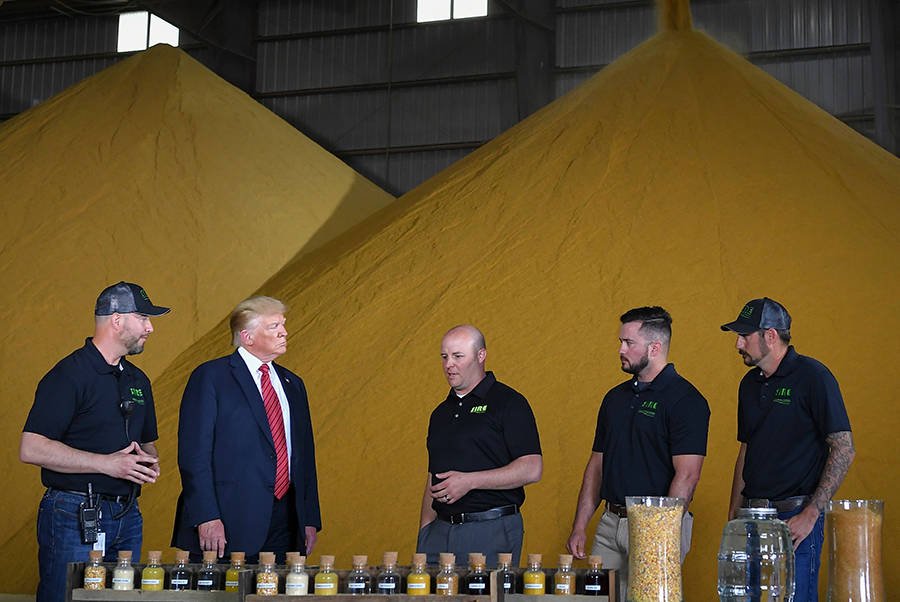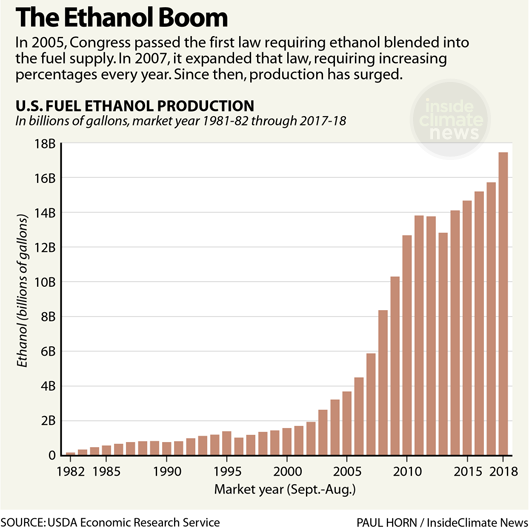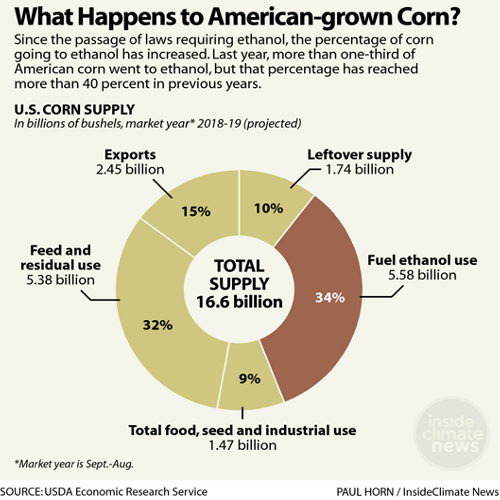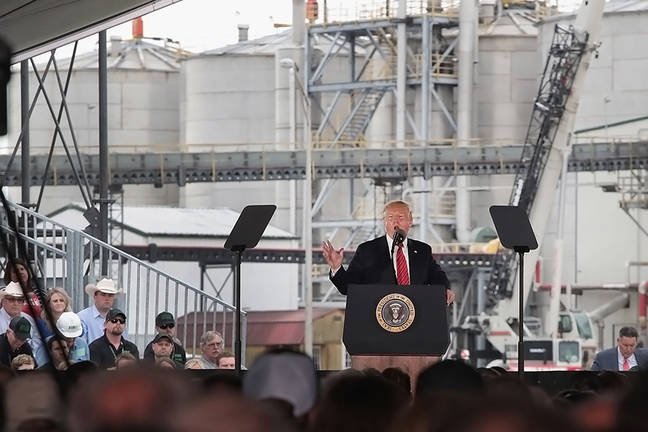
Date: 2025-10-15 Page is: DBtxt003.php txt00016853
Energy
About Ethanol
As Trump Touts Ethanol, Scientists Question the Fuel's Climate Claims
Peter Burgess
At a crucial moment in ethanol policy, the U.S. Department of Agriculture is doubling down on its argument that ethanol is better than conventional fuel.

President Donald Trump looks at samples of corn used in biofuels at Southwest Iowa Renewable Energy in Council Bluffs, Iowa, on June 11, 2019. Credit: Mandel Ngan/AFP/Getty Images
Shortly after touring an ethanol plant in Iowa this week, President Donald Trump stood in front of a crowd of farmers—a group of people who have every right to be upset with him.
Trump's trade war with China has bashed the struggling farm economy, but the president came to Iowa to share some popular news: His administration will allow the sale of more gasoline containing higher blends of corn ethanol.
'We celebrate the bright future we are forging together, powered by clean affordable American ethanol,' the president said to cheers.
The move handed farmers something they have sought for years—and delivered a politically strategic boost to Trump as he heads into an election. Midwestern farmers, after all, were critical to his victory in 2016.
But as the president touted the benefits of 'clean' ethanol, he touched on a central and controversial question in an ongoing battle between two of his key constituencies—Big Oil, which wants less ethanol in fuel tanks, and Big Ag, which wants more: Does corn-based ethanol really deliver benefits for the climate?
To support it's decision, the same administration that has been dismantling climate policies and denying the climate science is now proclaiming the climate benefits of ethanol, boosting the industry and appeasing farm-state political supporters in the process.
Scientists, meanwhile, are raising serious questions about the evidence the administration is using, and the Government Accountability Office (GAO), which reports to Congress, has questioned whether ethanol mandates deliver any greenhouse gas reductions at all.
In April, Agriculture Secretary Sonny Perdue, also firmly in the climate denial camp, touted what he called 'new' research on greenhouse gas emissions and biofuels to a room full of biofuel company executives.
'Biofuels from America's heartland reduce greenhouse gases even more than we thought,' Perdue declared in a press announcement.
The research immediately drew disapproval from biofuels critics and researchers, who questioned not just the findings, but the timing, coming just as the Trump administration was considering lifting the ban on year-round sales of higher ethanol blends.

Chart: The Ethanol Boom
The report's findings are, in fact, a recycling of previous agency-commissioned research—and just as controversial.
This month, the GAO reported that ethanol mandates have had a 'limited effect, if any, on greenhouse gas emissions.' The USDA criticized the GAO report, which was requested by a pro-oil Oklahoma congressman who has sought to unravel biofuels policy.
The divergent government reports, coming within months of each other, underscore just how contentious the battle over ethanol's climate benefits has become. Each side has deployed research demonstrating either that biofuels are more or less effective at cutting greenhouse-gas emissions. They have endorsed or financed conflicting studies published in scientific journals, including a spate of relatively new journals that focus on biofuels.
'There are peer-reviewed papers that dispute each other on all sides of the issue,' says John DeCiccio, whose research, including some supported by the oil industry, has said the greenhouse gas benefits of ethanol are negligible.
Yet, in this running contest of dueling research, the Agriculture Department has long supported the biofuels industry. Specifically, the office that published the recent research, the Office of Energy Policy and New Uses. Susan Offutt, who led the agency's Economic Research Service for 10 years, described it as an 'advocacy' office. 'It exists to find ways to expand uses for agricultural material for ethanol,' she said.
One of the agriculture industry's biggest priorities has been lifting a seasonal ban on the sale of E15, a gasoline with 15 percent ethanol that previous administrations prohibited from being sold during the summer months because it worsens smog.
Less than two months after USDA published its latest findings, the Environmental Protection Agency lifted the ban.
The Fight Over Numbers
Congress passed the 2007 Energy Security and Independence Act, now referred to as the Renewable Fuel Standard 2, with the goal of weaning the U.S. off foreign oil—and, importantly, delivering climate benefits in the process. The law requires that ethanol from new plants deliver a 20 percent reduction in greenhouse gases compared to gasoline.
After it became law, the EPA, which was charged with policing the 20 percent requirement, launched a new analysis to determine which fuels would qualify. The agency looked at emissions from refineries, farms and transportation related to ethanol, and eventually concluded that ethanol from a newly built factory, in the year 2022, would account for 21 percent less emissions than conventional fuel. That made corn ethanol qualify.
The corn industry, knowing this would boost demand for its product, breathed a sigh of relief.
But the following year, a research team led by Tim Searchinger of Princeton University published a study in the leading scientific journal Science that said corn-based ethanol doubled greenhouse gas emissions over 30 years. Increased demand for corn would push farmers around the world to rip up more forest and grassland, Searchinger projected, so more carbon would be released.
That research touched off a decade-long debate and an ongoing challenge by the biofuels and agriculture industries.

Chart: What Happens to American-Grown Corn?
'The issue is the land-use story,' said John Reilly, the co-director of the Joint Program on Science and Policy of Global Change at the Massachusetts Institute of Technology, who worked at the USDA for 14 years. 'That has been very controversial.'
Some researchers claimed that Searchinger's findings rested on inadequate scientific analysis. The biofuels industry has accused Searchinger of having a pro-fossil fuel bias, which he denies.
The American Farm Bureau Federation, the country's most powerful agricultural lobby, adopted an official position: Land-use change in foreign countries should not be factored into the emissions calculations of corn-based ethanol.
Meanwhile, environmental groups, which initially embraced corn ethanol mandates, began to rethink and reverse their positions.
The Intergovernmental Panel on Climate Change also changed course. In 2007, it called biofuels a potentially important 'key mitigation strategy.' But in its 2014 report, the IPCC said biofuels represented an 'emergent risk' because they could increase greenhouse gas emissions.
Now, more than a decade after Searchinger's report, the critical question remains: To what extent do ethanol mandates drive land-use change? And how much carbon is released?
'It's how much additional land is needed and where does it come from. That's a crucial issue,' Reilly said. 'Does it come from degraded pasture or the rainforest? The carbon implications are very different.'
Ag Emissions: More Complicated Than Oil
Researchers based their estimates of the greenhouse gas impacts of ethanol on complex models.
When tallying the carbon effects of burning petroleum fuel, researchers can simply look at the drilling, the refining and the burning of a gallon of fuel. But in agriculture, there are dozens of additional variables.
'On the agriculture side, you have to ask: Is it coming from a brand new field? How are you fertilizing? How are you generating the ethanol, and many other things,' said Aaron Smith, a professor of agriculture and resource economics at the University of California, Davis. 'The bottom line is you end up having a lot of modeling choices, which means if you want to find a favorable or unfavorable finding you can.'
The GAO report out last week says ethanol mandates have not significantly lowered greenhouse gas emissions. But the experts interviewed by the GAO conceded it 'is difficult to assess precisely because it involves complex factors that are challenging to quantify, including the lifecycle emissions associated with biofuel use.'
The report noted, as GAO has in the past, that advanced ethanol from other biomass, with potentially lower greenhouse gas emissions, has not been produced at the levels the mandate originally called for. That means most of the ethanol still comes from corn.
The USDA disagreed with the reports findings, saying that it downplayed the greenhouse gas benefits of corn ethanol and failed to incorporate findings from recent research—notably the research Sonny Perdue hailed to biofuels executives in April.
USDA Policy Wing Oversaw the Research
That latest USDA research found that corn ethanol emits 43 percent fewer greenhouse gas emissions than gasoline—the same finding as a USDA report released in 2017, written by the consulting firm ICF.
'The ICF report and the new paper—it's clear that most of the life-cycle stages have been analyzed in exactly the same way,' said Chris Malins, an expert on biofuels policy who runs the consulting firm Cerulogy.
After the initial USDA report, Malins submitted a 30-page critique to the department, which he says never responded. He plans to submit a letter to a scientific journal, calling out what he says are the new report's major flaws, including double-counting and incorrect figures.
'It's cognitive bias,' he said. 'You really have to want to believe in the benefit of corn ethanol.'

At a biofuels plant in Iowa on June 11, President Trump announced that the government would allow the sale of more gasoline containing higher blends of corn ethanol. Credit: Scott Olson/Getty Images
A major difference between the first and second reports was that a top USDA researcher led the second study, along with ICF researchers, and the study was published in the peer-reviewed journal Biofuels.
The report was overseen by the Office of the Chief Economist—a policy wing, not a research wing, of USDA.
'It might be rigorous, but they're only asking for evidence on one side of the question,' said Offutt, the former head of the Economic Research Service.
'Its history of publication tells you that it exists to find a way to expand uses for agricultural material for ethanol,' Offutt said. 'Is that what we expect for an objective research agency? I think your answer is no.'
When asked why the agency re-did the research, a spokesperson said the intention was to fix some methodological errors and submit the fixed version for peer review.
Findings Contradict Evidence from the Field
The authors of the new USDA study say its purpose was to update the EPA's regulatory impact analysis figures to reflect advances in technology that have boosted yields, making each acre more productive.
'Their number is lower than anyone else right now, which may be because of improving techniques and it may be because of errors,' said Wallace Tyner, a Purdue University agricultural economist, referring to the finding of lower emissions. 'The extent to which it's one or the other, I can't tell you.'
The USDA researchers also say less land was converted to growing crops in other countries than other researchers, including Searchinger, have projected, meaning more carbon-rich landscapes like forests stayed intact.
They add that growing corn for ethanol provides an emissions benefit because land planted in corn is better at storing carbon than pasture.
'The USDA study suggests domestic land use change somehow sequesters more carbon than it emits, resulting in a carbon credit for ethanol,' explained Tyler Lark, an associate researcher at the University of Wisconsin-Madison's Center for Sustainability and the Global Environment.
'This contradicts the majority of scientific evidence from the field, which shows that in most cases plowing up pasture and other perennial land cover to plant annual crops results in net carbon emissions.'
A study Lark published in April shows that cropland expansion, mostly for corn and soybeans, in the United States has led to more greenhouse gas emissions.
The model USDA used for its recent study says that higher demand for ethanol will increase yields on the same land, which would in theory increases carbon absorption on that land. But critics, including Searchinger, say that even if that were true, that highly productive land should be used for growing food.
Moving Researchers to Kansas & Other Changes
As Secretary Perdue proclaimed the greenhouse gas benefits of ethanol inside a USDA auditorium in April, the researchers at his agency were on the edge of revolt.
Perdue last year proposed relocating two major research wings—the Economic Research Service and the National Institute of Food and Agriculture, the agency's primary grant-making research division—out of Washington D.C. and placing them under the Office of the Chief Economist, a political office. This week, Perdue made the decision final, announcing that employees would be relocated to Kansas. Researchers, who recently unionized to protest the move, said it was a deliberate attempt to undermine their work.
Also last summer, the agency issued a memo instructing researchers to add a disclaimer to peer-reviewed research saying that the research 'should not be construed to represent any agency determination or policy.' (The agency later dropped that policy, after an outcry from researchers.)
Then, this March, the administration proposed slashing the ERS budget and its research staff in half, saying it wanted the agency to veer away from 'low priority research,' including environmental and climate research.
The agency has long had a promotional role. But now, critics say, even divisions that are strictly research-focused are under threat. Researchers have been leaving the agency in droves.
Meanwhile, the administration is trying to pacify the biofuels industry, which has chafed as the EPA grants waivers to oil refiners that exempt them from blending ethanol into their fuels. In March, the EPA proposed allowing the sale of E15 ethanol year-round, lifting the current restriction on selling it during the summer months.
The latest USDA research attempted to burnish ethanol's climate credentials as EPA contemplated the rule change. Then, in late May, the agency announced it would lift the ban.
The research comes as other countries consider their own renewable fuels targets. If American corn ethanol does, indeed, emit far less greenhouse gases, then it might qualify for renewable fuel mandates in foreign markets.
Indeed, the agency's report makes that aim clear: 'Many countries are now developing or revising renewable energy policies,' it says. 'Typically, biofuel substitutes for gasoline are required to reduce GHG emissions by more than 21 percent. Our results could help position U.S. corn ethanol to compete in these new and growing markets.'
And if those growing markets gobble up U.S. ethanol, they could create an overseas ethanol boom and turn even more of the best agricultural land in the world into fuel when global food demands are expected to soar.
'We have to produce 50 percent more food without clearing more land. And now somebody says: Here's what I want to do; I want to take the most productive cropland in the world and I'm going to use it for a little bit of greenhouse gas reductions,' Searchinger says. 'That can't possibly be the case. We can't solve climate change if we use the most productive land in the world for such a limited purpose.'
InsideClimate News reporter Dan Gearino contributed to this report.
Read more about agriculture and climate change in our award-winning series: Harvesting Peril: Extreme Weather and Climate Change on the American Farm.
PUBLISHED UNDER:
AGRICULTURE CLIMATE SCIENCE
CLIMATE CHANGE BIOFUEL DONALD TRUMP USDA
ABOUT THE AUTHOR
Georgina Gustin
Georgina Gustin is a Washington-based reporter who has covered food policy, farming and the environment for more than a decade. She started her journalism career at The Day in New London, Conn., then moved to the St. Louis Post-Dispatch, where she launched the 'food beat,' covering agriculture, biotech giant Monsanto and the growing 'good food' movement. At CQ Roll Call, she covered food, farm and drug policy and the intersections between federal regulatory agencies and Congress. Her work has also appeared in The New York Times, Washington Post and National Geographic's The Plate, among others.